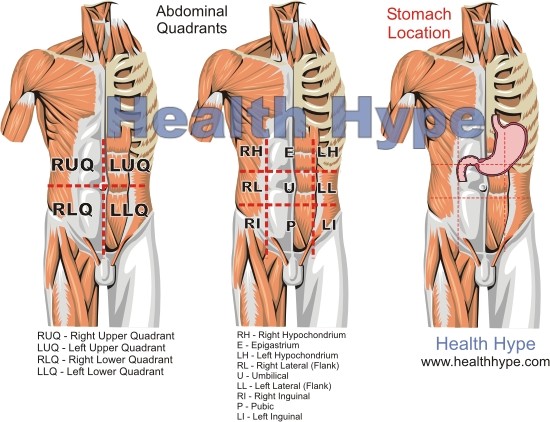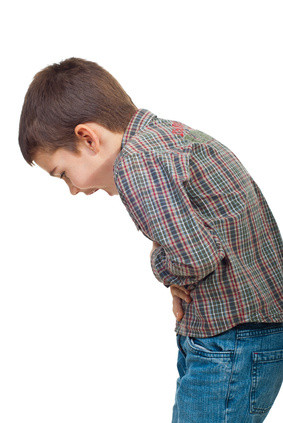Stomach Pain at Night (Digestive Nighttime Pain) Adults, Children
Stomach pain is a common term to describe upper abdominal pain, particularly pain or discomfort on the left side and center (epigastrium). The abdominal cavity contains many structures and organs, most of which are part of the digestive tract. It is lies next to the thoracic cavity which houses the heart and great blood vessels as well as the lungs and terminal airways. The abdominal cavity and thoracic cavity are separated by the muscular diaphragm.
Stomach pain may be associated with any of the structures contained within these two cavities and needs to be carefully assessed in conjunction with other symptoms to reach a possible diagnosis. This is further evaluated with diagnostic investigations. On its own stomach pain is not an extremely accurate indicator of a specific pathology.
It is largely non-specific and a common occurrence without any clear cause. Stomach pain may come and go sometimes with no correlation to specific events. It can be difficult to make a diagnosis from the pain on its own. Therefore concurrent symptoms need to be identified as far as possible.

Stomach Pain Worse at Night
Stomach pain at night is a symptom that may be specific for certain diseases but typically other clinical features will be evident. It can also be due to a host of causes that causes pain irrespective of the time of day. The first consideration when evaluating stomach pain at night is whether a meal was consumed recently (stomach pain after eating). This may be a more likely aggravating factor of a condition that presents with stomach pain rather than just the time of day.
Another common association with stomach pain that is more common at night is lying down, whether on the back (supine) or face down (prone). These changes from the upright position may also be a more likely factor for eliciting or aggravating pain associated with certain postures rather than time periods. However, the body’s natural 24 hour cycle (Circadian rhythm) also causes certain organs to become more or less active at certain times at the day and night. It is during these physiological changes in activity that pain may become apparent in a diseased organ.
Is it Stomach Pain?
It is difficult to correlate upper abdominal pain specifically with pain emanating from the stomach. Although the terms stomach and abdomen are commonly used interchangeably, it is essential to differentiate between pain in the anatomical region of the stomach and upper abdominal pain in general.
Position of the Stomach
The upper abdomen includes the right upper quadrant (RUQ) and left upper quadrant (LUQ). More specifically this includes the right hypochondrium (RH), epigastrium (E), left hypochondrium (LH) and superior (upper) parts of the right lateral (RL), umbilical (U) and left lateral quadrants as indicated in the picture below.

The anatomical location of the stomach as illustrated above indicates that it is largely or partially in at least four of these quadrants (E, LH, U and LL). While pain associated with the stomach would be more prominent in these quadrants, it is important to remember that the pain may radiate to surrounding areas and even refer to sites away from the stomach.
Pain that is associated with eating or drinking is a more conclusive indication of pathology within the stomach or other parts of the digestive tract rather than just the anatomical location. The position of a person – upright, supine or prone – may also alter the location of the stomach to some degree as well as distension of the stomach after eating particularly large meals.
Causes of Stomach Pain at Night
The main consideration when evaluating stomach pain is to ensure that it is not cardiac pain that is radiating to the epigastrium. This is common with a host of cardiovascular pathology, particularly ischemic cardiac pain. Severe pain that tends to radiate up to the neck, arm (generally left) and upper abdomen, breathlessness, unexplained sweating, paleness or bluish discoloration of the skin, and dizziness should all be considered as a a presentation of cardiovascular condition. It is a medical emergency that needs urgent care.
However, many gastrointestinal causes may elicit pain that closely resembles cardiac pain although the other concomitant symptoms are not present. Acid reflux is one of the more common of these causes. It can be confusing for the average person to differentiate between cardiac and esophageal pain, although any pain that is relieved by antacids is less likely to be cardiac. Nevertheless medical attention should be sought whenever in doubt. Read more on cardiac vs non-cardiac pain.
Symptoms of Painful Stomach Disorders
Conditions associated with gastric acid are more likely to be aggravated at night due to increased acid secretion and possible retrograde flow if the lower esophageal sphincter is compromised. The more common causes of pain that tends to worsen or start at night includes :
- Gastritis. Inflammation of the stomach wall that is more commonly caused by H.pylori infection or NSAIDs. It typically presents with a gnawing and nagging pain that may be worse after eating and at night during sleep. Nausea, vomiting, indigestion and belching are other symptoms that may be noted.
- Peptic ulcers. Open sores in the stomach and/or duodenum (first part of the small intestine). Pain is generally more severe than gastritis and may be eased to some extent with eating (stomach ulcers) or worsened a short while after eating (duodenal ulcers). Other symptoms like nausea, indigestion, vomiting and belching are common.
- Acid reflux. Backward flow of the stomach contents into the esophagus that typically causes heartburn (burning chest pain). Acute acid reflux is more frequently associated with excessive alcohol consumption, overeating, exercising or lying flat after meals. In chronic reflux (GERD ~ gastroesophageal reflux disease), the backward flow of gastric acid into the esophagus may occur independent of meals. Since the lower esophageal sphincter is compromised in GERD, lying flat will allow even minute amounts of acid to flow into the esophagus and elicit pain. Other symptoms may include nausea, vomiting or regurgitation, morning sore throat, belching, and sensation of pressure in the chest (bloating).
- Gallstones. Gallstone pain tends to occur in attacks when the stones lodge in the bile duct. It is more likely to occur after a fatty meal and also at night. The pain is typically excruciating, more towards the right upper abdomen and extending to the shoulder. Nausea, vomiting, fever, jaundice and pale stools are other features that may be present to varying degrees.
- Pancreatitis. Acute inflammation of the pancreas (acute pancreatitis) is usually of sudden onset with intense pain, nausea, vomiting and fever. The pain tends to radiate to the back and is moderately relieved from bending over or lying in the fetal position. Acute pancreatitis is more frequently seen in association with overindulgence in alcohol and repeated attacks are common in alcoholics.
Conditions that are more common in the lower gastrointestinal tract may extend upwards into the proximal parts of the small intestine and stomach. However, the location of the colon, the transverse colon in particular, may present as upper abdominal pain.
- Inflammatory bowel disease. Chronic inflammation of the bowels characterized by two major conditions – Crohn’s disease and ulcerative colitis. Abdominal pain is more common with Crohn’s disease which also presents with watery, large-volume diarrhea and weight loss. Pain is prominent in acute episodes of both Crohn’s disease and ulcerative colitis and is usually worse with eating or defecation in Crohn’s disease but temporarily relieved with defecation (bloody, mucus diarrhea) in ulcerative colitis.
- Irritable bowel syndrome. Despite the name, irritable bowel syndrome (IBS) tends to cause many symptoms in the upper gastrointestinal tract. This may include excessive belching, abdominal distension and bloating, apart from the change in bowel habit and intestinal cramping when present. Generally the symptoms of IBS ease at night during sleep and are worse in the day but symptoms may exacerbate at night,particularly when associated with the intake of trigger foods and drinks, cigarette smoking or stress.
Nighttime Stomach Pain in Children
Many of the causes listed above affects both children and adults. Although gastritis, ulcers and acid reflux was traditionally considered to be disorders affecting adults primarily, it is now known that children may be equally afflicted.
 However children present slightly differently and may not report symptoms as accurately as adults.Pain will lead to irritability, night time awakening and children often complain of the need to defecate as they misunderstand the nature of the pain. Vomiting is a common feature associated with pain and fever indicates an infectious cause.
However children present slightly differently and may not report symptoms as accurately as adults.Pain will lead to irritability, night time awakening and children often complain of the need to defecate as they misunderstand the nature of the pain. Vomiting is a common feature associated with pain and fever indicates an infectious cause.
Read more on stomach pain in children.
Two conditions in children that are better understood in recent years are cyclic vomiting syndrome and abdominal migraines. These terms are often used interchangeably since vomiting is prominent in abdominal migraines and abdominal pain is prominent in cyclic vomiting syndrome. The dominant symptom determines which label will be used.
Cyclic vomiting syndrome is recurrent episodes of vomiting. Abdominal migraines is recurrent episodes of abdominal pain for no known cause and more often seen in children with a family history of migraines (head). Both conditions tend to worsen at night.
Parents are sometimes quick to label stomach pains as a means of seeking attention, avoiding undesirable tasks or playing ‘sick’ from school. Indeed where adults manifest with headaches, children tend to complain of stomach pains. However other symptoms should be noted and the reports taken seriously if there are any other severe symptoms or the child is becoming pale, listless or displaying uncharacteristic behavior.
References
- Severe abdominal pain. Harvard Health
Last updated on September 8, 2018.





